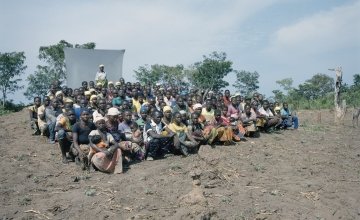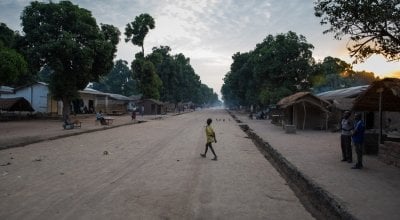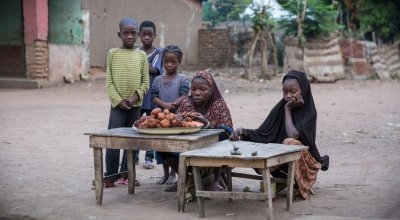
Knowledge Hub
Ending hunger is possible, if we can cut conflict

With hunger on the rise globally for the first time in 15 years Simon Starling, Director of Policy and Campaigns, explores its links with conflict and what can be done.
In my 20+ years working in international development, I’ve seen some incredible stories of progress and inspiration around the world. I’ve also seen some of man’s lack of humanity to his fellow man, and plenty of statistics of humanitarian need and desperate poverty that back it up. Two statistics in particular shocked me recently. The first is global hunger levels bucking an overall declining trend, and the second is on the nature of modern day warfare – where 80% of the casualties are now innocent civilians. The two are linked – it is conflict that is the primary driver of the increase in hunger levels. On hunger, we more or less know what we need to do to end it for good, assuming we can generate the political will and the resources. However, on conflict, the international systems and processes set up to deal with it are failing. The rightly ambitious aims to end global hunger, poverty and conflict set out in the Sustainable Development Goals – an example of man’s ability to come together and at least plan to help his fellow man – will be a long way off target unless the scourge of conflict is addressed.
Hunger is on the rise for the first time this century
Hunger should not be a feature of the 21st Century. The world produces enough food for us all, and hunger levels globally had been on the decline for decades. But in 2016, for the first time in more than 15 years, the number of hungry people rose by 38 million to 815 million. Last year catastrophe loomed, with famine declared in South Sudan and three other countries - Somalia, Yemen, and Nigeria – teetered on the brink of famine. What these four very different countries have in common is conflict and violence. In fact, 60 per cent of the world’s hungry people live in conflict zones, and the UN estimates 80 per cent of its humanitarian funding needs are conflict driven.
The casualties of war are civilians
Gone are the days when armies of men fought other armies of men on a remote battlefield. In the First World War, 95% of the casualties were soldiers. Today, 80 per cent of are civilians - women, children and men – innocents engulfed in the conflict surrounding their towns, villages and cities.
The impact of conflict on hunger

When conflict approaches, ordinary people know they will be in the firing line, and are forced to do whatever it takes to survive. Often this means selling all their possessions or livestock, or fleeing their homes in search of safety, leaving behind their means of making a living. This leaves them struggling to feed their families, and often dependent on the generosity of local people or aid agencies. When compounded with existing poverty levels, conflict can be catastrophic. Take the Central African Republic (CAR), for example. In the Global Hunger Index (insert link please) produced annually by Concern Worldwide and its partners, CAR ranked last – the hungriest country in the world– as well as bottom of the Human Development Index. Already a poor and vulnerable country, the recurrence of conflict since 2013 has driven over a million people, a fifth of the entire population, from their homes. More than 2.5 million people, over half the population, are in need of humanitarian assistance. Farmers won’t invest in crops that take more than three months to grow because they fear having to flee, and are forced to survive on a desperate diet of cassava leaves. Yet, despite the clear need, CAR does not receive the international support it needs. The UN’s Humanitarian Assistance request has consistently been under half met over the last five years (see UN pictoral graph). While Concern has been able to scale up its work, other international organisations have been forced to abandon their operations lacking the funds to continue.
What can be done?
Despite the challenges, Concern’s experience on the ground tells us this desperate need can be tackled. We largely know what’s needed to address hunger, and when there is sufficient political will we can mobilise the resources needed to make a difference. In Somalia last year, for example, the combined efforts of local people, the government, donors and aid agencies prevented widespread famine. Concern’s staff used their many years of experience in Somalia to anticipate the food crises and act ahead of the crisis, with rapid financial support from UK Aid, enabling people to stay in their homes rather than abandon them in search of food, and even host those in need from nearby villages. In countries such as CAR, where food crises and conflict have become a recurring fact of life, addressing people's short term humanitarian needs whilst simultaneously helping them build their resilience to future threats has proven effective. This means helping people strengthen and diversifying their livelihoods, and plan ahead to cope with disasters when they strike.
Addressing the systemic challenges to Leave No-one Behind
The principle of ‘Leaving no-one Behind’, and helping those most in need first underpins the Global Goals. This is the right thing to do, but it is harder to do than it is to say. This is because it means tackling the intertwined issues of conflict, poverty, hunger and inequality in places like CAR, South Sudan, Yemen, Syria and Somalia. If it is serious about reaching the Sustainable Development Goals, the international community must find more resources to support those left behind, like the people living in CAR. This means increased investment in nutrition programming, building communities resilience and long-term humanitarian assistance where it’s most needed.
More challenging is the critical need to prevent and bring an end to the vicious and protracted conflicts currently dogging the world. The international security system, principally the UN Security Council, set up after the Second World War explicitly to prevent further global conflicts, has manifestly failed. The conflict in Syria in particular has undermined international norms and conventions around the rules of war and humanitarian assistance, with the Security Council not only paralysed by inaction, but part of the problem with its members taking part in the fighting. This failure of global governments to prevent and resolve conflict is the single biggest challenge facing our world today, and to any chance of reaching the Sustainable Development Goals. Yet it’s also the least invested in, with minimal investment in conflict prevention and resolution. I hope that the new UN Secretary General’s focus on conflict reduction will bring some impetus to this cause. But ultimately the behaviour of States must change if we are to break the deadly cycle of conflict, poverty and hunger.
Simon Starling
Head of Policy and Campaigns






